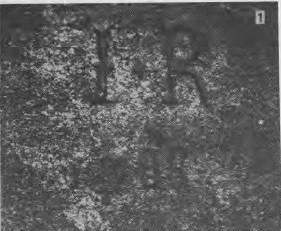- Author
- Rivett, Norman C
- Subjects
- History - pre-Federation
- Tags
-
- RAN Ships
- None noted.
- Publication
- June 1993 edition of the Naval Historical Review (all rights reserved)
The first account of a landing on the Garden Island, and the first reference to it by that name, is the entry in the log book of H.M.S. SIRIUS under the date of 11th February, 1788 and it reads as follows: “Sent an Officer and party of men to the Garden Island to clear it for a garden for the ship’s company“. Oddly, the Officer is not identified by name. It is however certain that Frederic Meredith was not one of the seamen, for the log of the SIRIUS records him as joining the ship from the SCARBOROUGH on the 2nd May, 1788.
Captain John Hunter and First Lieutenant Bradley carried out the first survey of Port Jackson as early as the 28th January, 1788, and it is highly probable that Bradley, during later surveys, took sightings from Garden Island, the initials “WB” could therefore be his official survey reference. There is a line of sight from the reference point to Bradley’s Head, which in 1788 would have been even clearer with the lesser number of trees on the Island.
If this is in fact Bradley’s survey reference, it would account for the detachment from the other two sets of initials, which are more than likely those of the other members of the survey party who carried the equipment and had access to the tools.
Who were these other members of the party? To deduce this one must reason like a First Lieutenant who has to leave his ship on detached duty. His first concern is for the continued safety and well-being of the ship during his absence. He would therefore not select the very best men available, such as seamen and carpenters, but rather the best men for the task ahead whose absence would not unduly disrupt the ship’s routine.
One such man was Frederic Meredith who had arrived in the Colony in the SCARBOROUGH as the Captain’s servant. He was a baker by profession, more importantly, he could read and write. Before the SCARBOROUGH sailed for China on the 6th May, 1788, Meredith was transferred to the SIRIUS as an AB. The initials were therefore carved sometime between the 2nd May, 1788 and the 2nd October, 1788 when SIRIUS sailed for Cape Colony.
From Bradley’s point of view, Meredith as a newcomer to the ship, not being a professional seaman, possessing the ability to read and write, being only 23 years of age and a presentable person, met the criteria perfectly.
The third man, with the initials “IR”, proved to be difficult to identify as no one in the SIRIUS had these initials, or so it appeared. In fact, in the whole of the First Fleet only two persons possessed these initials, a thirty-three year old female convict named Isabella Rawson or Rosson, who was transported in the LADY PENRHYN and a male convict aboard the ALEXANDER named Isaac Rogers, who died at sea before reaching Botany Bay.
|
|
This 1922 photograph of the engraved initials “IR” was taken by Surgeon Lieutenant W.E.J. Paradice, R.A.N., who was tragically drowned in the GREYCLIFFE – TAHITI disaster in Sydney Harbour at 4.30 p.m. on the 3rd November, 1927.
The letters are neatly formed and of uniform size, with serifs proving that the “I” was never a standard “J” as we know it. The stock of the “I” is crossed, a style adopted by Silversmiths at various periods before and after 1788. A full stop punctuation is placed between the letters at mid height. |
At this point I conceded defeat. There was no question in my mind that the first letter of the initials had ever been other than “I”. I had often studied the rock bearing the initials, and had sighted the 1922 photograph of the initials. The letter is clearly an “I”.
On the 10th March, 1988, I received the following letter from Mr. Tony Dawson of Melbourne, who provided the clue.
“Dear Norm,
I was one of the group from the Institution of Engineers who visited the museum a couple of weeks ago.
As discussed, I enclose some copies of the silvermakers’ initials recorded during the Georgian era. You will see that people with names we would now spell with a “J”, i.e. John, James, Jeremiah, etc., mostly used “I” as their first initial. Does that open up new possibilities for “IR” carved on the rock? I would be interested to hear if you can match this with any of the crew of the SIRIUS.
Yours sincerely,
Tony Dawson.” Using this fresh approach and applying the First Lieutenant’s criteria for selection of a survey party, two possible candidates emerged from the crew list of SIRIUS.





